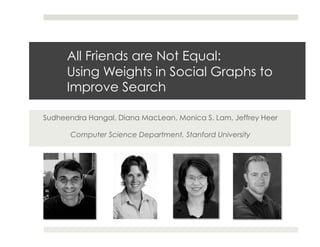
Maclean.pptx
- 1. All Friends are Not Equal: Using Weights in Social Graphs to Improve Search Sudheendra Hangal, Diana MacLean, Monica S. Lam, Jeffrey Heer Computer Science Department, Stanford University
- 2. Outline Problem: social search in a global network Most contemporary approaches optimize for path length Tie strength not considered Success can be highly path dependent Question: Could a longer path be better? More likely to get an introduction through people who like me. If not, is there a best shortest path? Contributions: Influence as a model of tie strength in directed & undirected networks Best path = most influential path Study of influence and optimal paths in 2 networks (Twitter RT & DBLP) Results The shortest path is not always the best path!
- 3. Social Search Scenario John’s HR College Manager’s Roommate Brother Google John HR Manager Google Recruiter John would like to apply for a job at Google. What is the best path to the HR manager? James thinks Mary is cute. Who is the best person to ask for an introduction? …
- 4. <Graphic of LinkedIn showing hundreds of paths>
- 5. Assigning Tie Strengths A social tie may be both weighted and asymmetric Infer automatically Most users would not input in any case Based on interaction frequency Latently captured in many social networks (emails, co-authorships…) Involves cost investment from user, so good proxy for tie strength We assume a global view of the data
- 6. Influence X’s influence on Y is proportional to Y’s investment in X Assume each node has equal, fixed resources to invest Influence of an edge: Invests(B, A) Inf luence(A, B) = X Invests(B, X) Influence of a person: Inf luence(A) = Inf luence(A, X) X Influence is both asymmetric and weighted
- 7. Influence Co-Authorship Influence 7 0.75 6 0.35 2 4
- 8. Influence of a Path Influence of a path: S(P ) = D |P | Inf luence(ei ), ei ∈ P Decay factor d damps influence as path length increases Many other models This one is simple Strongest path = most influential
- 9. Computing the Strongest Path Adaptation of Djikstra’s shortest path algorithm. In order to maximize S(P): S(P ) = (D × Inf luence(ei )), ei ∈ P = (log(D) + log(Inf luence(ei )), ei ∈ P Thus minimizing: − (log(D) + log(Inf luence(ei ))), ei ∈ P 1 1 = (log( ) + log( )), ei ∈ P D Inf luence(ei ) We provide log(1/D) + log(1/Inf luence(ei )) as the starting weights to the shortest path algorithm.
- 10. Networks Studied DBLP Investment: co-authorship ~600K nodes, ~4M edges (giant component only) Example of influence relationship: earlier slide Twitter RT Investment: re-tweeting someone’s tweet 1 month’s worth of tweets ~2.4M nodes, ~8.85M edges (giant component only) Example of influence relationship: Obama Joe the Plumber
- 11. Obama Joe Joe the Plumber Obama
- 12. Experiment Pick 500 random node pairs Compute: Strongest path Shortest path Questions Do stronger paths tend to be longer? Equivalent to shortest path? What proportion of stronger paths are longer? How is influence distributed across nodes?
- 13. Results Node influence distributions
- 14. Results Short vs. Strong paths DBLP All |Pstrong| |Pshort| |Pshort| = |Pstrong| Node Pairs 500 215 (43.0%) 285 (57.0%) Avg. |Pshort| 6.5 6.6 6.5 Avg. |Pstrong| 7.0 7.8 6.5 TWITTER All |Pstrong| |Pshort| |Pshort| = |Pstrong| Node Pairs 500 339(67.8%) 161 (32.2%) Avg. |Pshort| 7.7 7.9 7.3 Avg. |Pstrong| 9.2 10.1 7.3
- 15. Discussion (1) Influence metric Captures asymmetry at the node level – most have influence 1 Differences between Twitter and DBLP datasets Twitter outliers DBLP outliers Twitter more sparse than DBLP Twitter, driven by popularity hype, lends itself to influence?
- 16. Discussion (2) Stronger path longer than shortest path 43% in DBLP (~1 extra hop compared with shortest path) 68% in Twitter (~2 extra hops compared with shortest path) More worthwhile to pick the stronger path Strongest path length equal to shortest path length Still better to pick the strongest, shortest path Future work: Explore alternate models of influence Consider paths between n-degree connected pairs.
- 17. Related Work Global social search Aardvark [Horwitz Kamvar, WWW ’09] Facebook (and other OSN companies) Local social search [Dodds et al., Science, August ’03] [Adamic Adar, Social Networks, July ’05] [Watts et al., Science, May ’02] Inferring tie strengths from social graphs [Gilbert Karahalois, CHI ’09], [Xiang et al., WWW ’09], [Leskovec et al., CHI ’10], [Onnela et al., NJP, June ‘07]
- 18. Conclusions Longer paths are often better than shortest paths Cost of 1-2 extra “hops” seems small for tasks that are highly path dependent Even when the better path is not longer it is still better that picking randomly from the set of shortest paths In general, we need to develop more graph analysis methods for weighted graphs Binary ties are often arbitrary Weights can be easily inferred Weights encode a wealth of social information Influence metric Simple Applicable to any graph encoding social interactions
- 19. Thank you! Questions? http://prpl. stanford.edu/influence